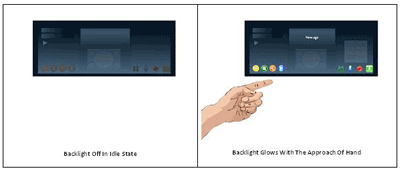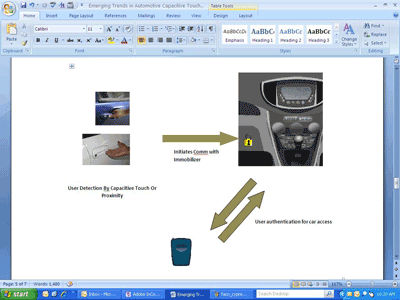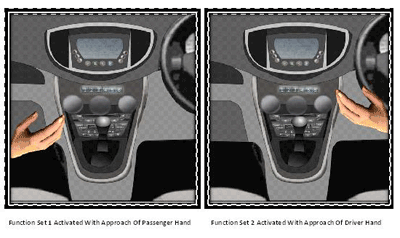Emerging trends in automotive capacitive touch sensing
Simplifying and improving user interfaces through the vehicle
PREM ARORA MANU VERMA
Cypress Semiconductor
San Jose, CA
www.cypress.com
Capacitive touch sensing has been traditionally used as a design differentiating technology to enable superior aesthetic designs for automotive infotainment applications. With devices maturing to the point of integrating automotive specific functions, engineers are developing newer applications exploiting capacitive-sensing technology that go beyond infotainment applications to simplifying and improving numerous user interfaces through the vehicle. Combined with proximity sensing and automotive-specific features such as standard networking protocol support (including LIN and CAN), capacitive touch sensing is becoming a mainstay technology in automotive designs.
Over the last century, the automobile has been transformed from a motley amalgamation of mechanical components to a highly efficient, lavishly comfortable, and safer machine. This revolution has largely been made possible by the increase in the amount of electronics in a car. One constant, however, is that customer satisfaction has always depended on how easily and effectively people can interact with the car. Whether it is the driver interacting with the controls or the passenger with the entertainment unit, the pleasure derived from owning a car is still largely dependent on this interaction.
The systems measuring and tracking user interactions as well as providing feedback to the main control systems – are collectively known as automotive human-machine interface (HMI) systems. From a user’s perspective, these interaction may be conscious (such as when a passenger deliberately provides input to a system) or subconscious (such as when the system measures the driver’s intent without the driver being aware of this). In addition, the increase in complexity of the various systems in a car makes it necessary for the systems to be more responsive and aware of human interaction.
Capacitive sensing ushering in a revolution in automotive HMI
Engineers are constantly trying to improve HMI systems to make them more intuitive, appear “cooler,” and be more accurate. At the heart of this current wave of change is capacitive sensing, which revolutionizes the design and implementation of HMI applications.
Simply put, a capacitive sensor is composed of a pair of adjacent electrodes. When a human being (or any other conductive object) comes in proximity to these electrodes, there is additional capacitance between the electrodes and the object which can be measured to detect the object’s presence. The ability to detect the presence of objects is the foundation to creating a variety of touch sensors that can serve as buttons, sliders, trackpads, and other common interface components.
Alternatively, capacitive sensing can be used for proximity sensing where no contact is required between the sensor and the user’s body. This can be achieved by increasing the sensitivity of the sensors. Furthermore, since such sensors are free of line of sight constraints, a single sensor can detect an object’s direction-of-approach in three dimensions.
Such a technology becomes even more powerful in conjunction with programmable mixed signal controllers. Programmable devices enable the intelligent measurement of capacitance to enable the detection of human proximity across multiple characteristics: range, direction-of-approach, gesture recognition, and many others. Programmable approaches also enable the possibility of integrating other functions like motor control and driving LEDs to provide feedback to the user based on touch/proximity (see below). A programmable device also allows developers to significantly improve performance by defining, for example, optimal sensitivity thresholds and variable scan speeds that reduce current consumption and improve noise immunity.
Capacitive sensing a mature technology
Over the last 5 years, capacitive touch sensing has been increasingly used to replace mechanical buttons with touch sensitive buttons for infotainment systems in automobiles. Many consumers are already familiar with capacitive touch controls in navigation systems which include “fixed” buttons whose function changes depending upon which menu is active, sliders for zooming the display in or out, and controls that appear when needed on the main display. These systems control a wide range of functions within the vehicle, including navigation, audio, HVAC, and overall vehicle management.

Fig. 1. Hybrid touch technology implementation.
Capacitive touch sensing can also be used in conjunction with mechanical buttons to provide enhanced, hybrid buttons (see Fig. 1 ) that respond to both proximity/touch (such as to preview a function) and physically pressing a button (such as activation of the function), as illustrated below.
These applications can be further enhanced through the use of capacitive-sensing-based proximity sensors. For example, consider a panel that, depending upon the proximity of the user, activates the backlight control (see Fig. 2 ).

Fig. 2. Proximity-based car audio backlight control.
Factors supporting capacitive sensing in automotive applications
As capacitive-sensing technology continues to mature, electronic design engineers are finding innovative, new uses for it within the automotive environment. Two primary factors contributing to the proliferation of this technology into automotive environments are support for automotive-specific communication protocols and the availability of robust IC technology.
Touch-sensing controllers have started to support automotive-specific communication protocols like LIN and CAN. With increasing demand for a distributed architecture between touch panels and system ECUs (see Fig. 3 ), support for CAN and LIN on touch-sensing controllers enable system designers to minimize the total number of external components required while improving reliability and lowering BOM cost. In addition, the trend of integration enables many other functions, which have traditionally been implemented on one of these network busses, to be easily migrated to the touch-sensing controller.

Fig. 3. Distributed HMI architecture.
The increasing availability of mature, robust ICs integrated with capacitive sensing has enabled semiconductor companies to manufacture new devices with faster scan rates, better noise immunity, and low power consumption. This coupled with an increasingly experienced application engineering community is proving to serve as a strong catalyst for the expansion of capacitive-sensing technology into newer application areas. Some of these innovative applications include:
Capacitive-sensing-based passive keyless-entry systems. Passive keyless-entry systems have been around for some time. Recently, capacitive sensing has begun to be used to detect the approach of the driver’s hand. This automatically initiates encrypted communication between the keyfob located in the driver’s pocket and the immobilizer in the car. Once authenticated, the driver is granted access to enter the car and drive away without ever needing to remove the key from his or her pocket (see Fig. 4 ).

Fig. 4. Capacitive touch sensors in passive keyless-entry systems.
Proximity-based detection of direction-of-approach to center console. Capacitive proximity sensors in the center console of a car can be used to implement multiple customizable features depending upon the direction- and distance-of-approach of a person’s hand. This enables the center console to adapt to or change its response depending on whether the driver or the passenger is approaching the center console (see Fig. 5 ).

Fig. 5. Center stack function control based on direction of approach.
Indoor illumination control . Capacitive proximity sensing also provides an efficient means for implementing range-sensitive illumination control for various indoor and outdoor car systems. Examples of such systems include proximity-based compartment lighting, proximity-based backlighting for door handles with the intensity control based on the range of the hand as it approaches, and touch/proximity-based dome light across a LIN interface. ICs which combine capacitive touch sensing, LIN communication support, and LED-dimming capabilities can provide a single-chip implementation for such applications.
Capacitive touch sensor-based switches. Touch buttons are gradually getting more popular and replacing mechanical switches and buttons due to their superior aesthetics, flexibility, and reliability. Emerging applications include using capacitive touch buttons to control various mechanical functions in the car such as operating the sunroof, windows, door locks, side mirrors, and key fob. For external functions, such as opening the trunk, capacitive touch technology also provides an efficient, waterproof implementation. Many of these applications are further being proliferated because of availability of LIN/CAN communication protocols.
Liquid level sensors. Apart from human-presence sensing, capacitive sensing can also be used to measure the presence of liquids for fuel level, brake fluid level, and coolant level detection.
From making infotainment systems cooler to providing a reliable methodology for measuring liquid levels, capacitive sensing is proving to be an immensely popular and useful sensing technology for use in the automotive applications. Combined with the ability to manage LCDs and pass control data to system modules using interfaces like LIN and CAN enable developers to move to a single-chip implementation that both simplifies and reduces cost.
Today, the potential of capacitive is just beginning to be tapped with the introduction of next-generation mixed-signal controllers designed specifically for the automotive industry. As these systems continue to become more demanding, designers will find that capacitive sensing provides an effective interface technology for a wide gamut of applications. ■
Advertisement
Learn more about Cypress Semiconductor





